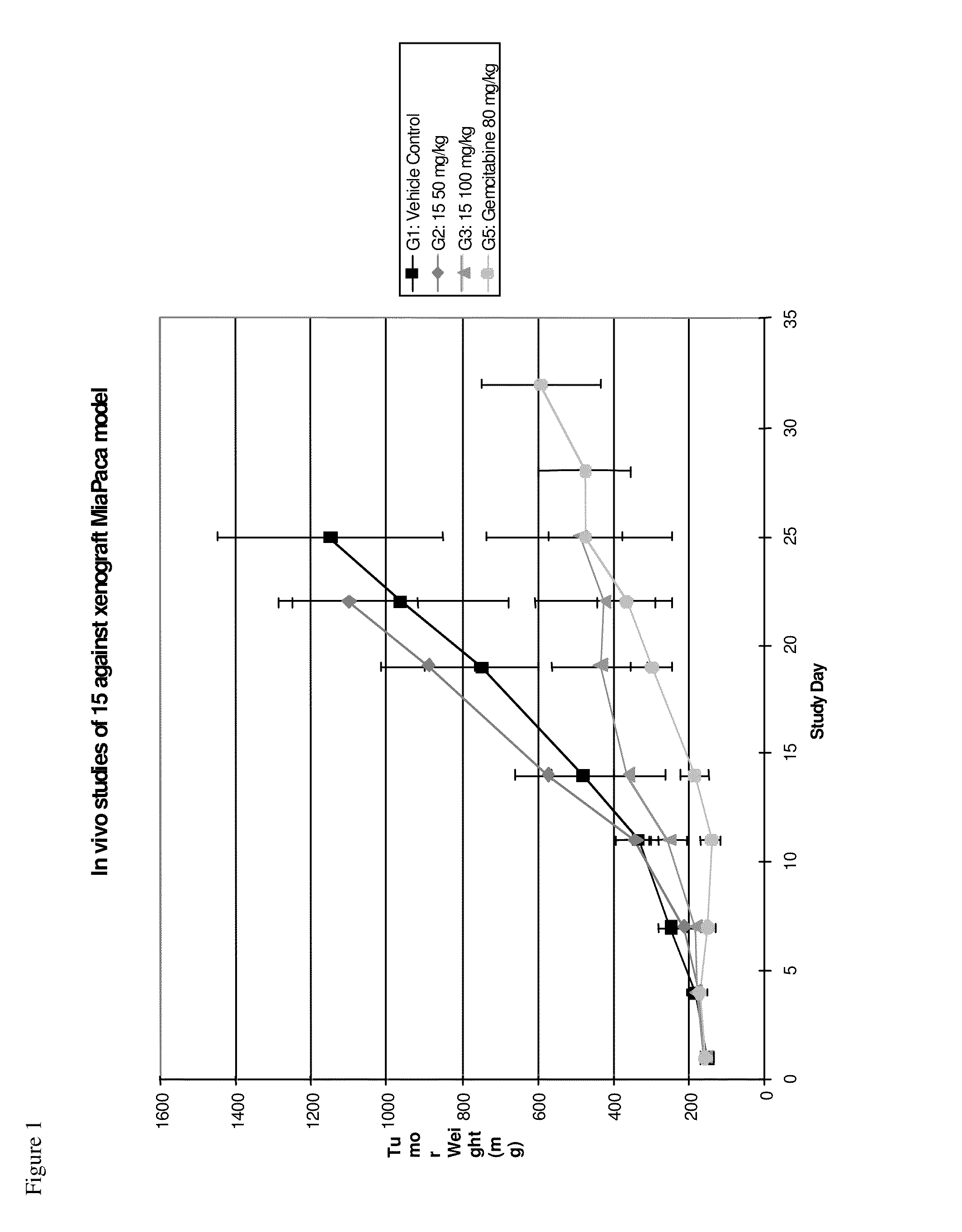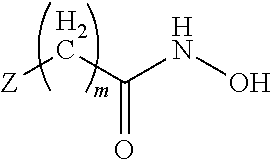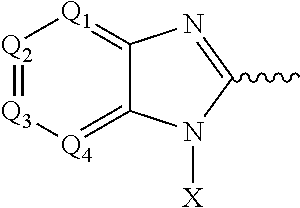Compounds, pharmaceutical compositions and methods of use of hydroxamic acid derivatives
a technology of hydroxamic acid and derivatives, applied in the field of pharmaceutical compositions and methods of use of hydroxamic acid derivatives, can solve the problems of many cancers that are resistant to treatment, many cancers that are often resistant to treatment, and a wide range of undesirable side effects, so as to slow down the expansion of cancer cells
- Summary
- Abstract
- Description
- Claims
- Application Information
AI Technical Summary
Benefits of technology
Problems solved by technology
Method used
Image
Examples
example 1
7-(5-bromo-1H-benzimidazol-2-yl)-N-hydroxy heptanamide (ID#15)
[0087]To a solution of methyl 8-chloro-8-oxooctanoate (229 mg, 1.11 mmol) in DMF at 0° C. was added a solution of 4-bromo-2-nitroaniline (200 mg, 0.922 mmol) and triethylamine (0.37 mL, 2.77 mmol) in DMF drop-wise. The reaction was stirred overnight at room temperature, diluted with ethyl acetate and washed with 1 N HCl, saturated sodium bicarbonate solution and brine. The separated organic layer was concentrated and purified by biotage column chromatography to give methyl 8-(4-bromo-2-nitrophenylamino)-8-oxooctanoate (290 mg)
[0088]To a solution of methyl 8-(4-bromo-2-nitrophenylamino)-8-oxooctanoate (241 mg, 0.623 mmol) in EtOH was added SnCl2.H2O (490 mg, 2.37 mmol). The reaction was heated to reflux overnight and quenched by water. The mixture was filtered and the filtrate was extracted with ethyl acetate. The combined organic layer was dried, concentrated and purified by biotage column chromatography to afford methyl ...
example 2
N-hydroxy-7-(5-phenyl-1H-benzo[d]imidazol-2-yl)heptanamide (ID#18)
[0091]To a mixture of 4-bromo-2-nitroaniline (217 mg, 1.0 mmol), phenylboronic acid (122 mg, 1.0 mmol), tetrakis-(triphenylphosphine)palladium (55 mg, 0.05 mmol) and cesium carbonate (650 mg, 2.0 mmol) was added 3 mL of ethyleneglycol dimethyl ether (DME). The reaction was heated to 80° C. and stirred under nitrogen atmosphere overnight. The mixture was filtered through a celite pad. The filtrate was concentrated and purified by biotage column chromatography to give 4-nitrobiphenyl-3-amine (207 mg)
[0092]To a solution of methyl 8-chloro-8-oxooctanoate (200 mg, 0.97 mmol) in DMF at 0° C. was added a solution of 4-nitrobiphenyl-3-amine (207 mg, 0.97 mmol) and triethylamine (0.46 mL, 3.3 mmol) in DMF drop-wise. The reaction was stirred overnight at room temperature, diluted with ethyl acetate and washed with 1 N HCl, saturated sodium bicarbonate solution and brine. The separated organic layer was concentrated and purified...
example 3
7-(1-cyclopropyl-1H-benzo[d]imidazol-2-yl)-N-hydroxyheptanamide (ID#24)
[0096]To a solution of 1-fluoro-2-nitrobenzene (0.50 g, 3.5 mmol) in ethanol was added cyclopropyl amine (0.60 g, 10.5 mmol). The solution was heated to 80° C. overnight and concentrated. The residue was purified by biotage column chromatography to give N-cyclopropyl-2-nitroaniline (0.60 g)
[0097]To a solution of N-cyclopropyl-2-nitroaniline (365 mg, 2.05 mmol) and ammonium formate (516 mg, 8.2 mmol) in methanol was added catalytic amount of palladium on carbon (5%). The mixture was heated to reflux under a nitrogen atmosphere overnight and filtered. The filtrate was concentrated and purified by biotage column chromatography to give N1-cyclopropylbenzene-1,2-diamine (296 mg)
[0098]To a solution of N1-cyclopropylbenzene-1,2-diamine (221 mg, 1.49 mmol) and triethylamine (0.3 mL, 2.2 mmol) in DMF was added a solution of methyl 8-chloro-8-oxooctanoate (260 mg, 1.3 mmol) in DMF at 0° C. drop-wise. The reaction was stirr...
PUM
 Login to View More
Login to View More Abstract
Description
Claims
Application Information
 Login to View More
Login to View More - R&D
- Intellectual Property
- Life Sciences
- Materials
- Tech Scout
- Unparalleled Data Quality
- Higher Quality Content
- 60% Fewer Hallucinations
Browse by: Latest US Patents, China's latest patents, Technical Efficacy Thesaurus, Application Domain, Technology Topic, Popular Technical Reports.
© 2025 PatSnap. All rights reserved.Legal|Privacy policy|Modern Slavery Act Transparency Statement|Sitemap|About US| Contact US: help@patsnap.com



